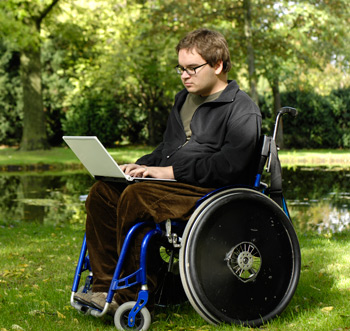Description
Muscular Dystrophy (MD) is a disease where muscles become weak over time. Often MD impacts the muscles that move the limbs and trunk. It may also affect involuntary muscles like the heart. MD is inherited, and gets worse over time.
There are more than 30 types of MD. Duchenne Muscular Dystrophy (DMD) and Becker Muscular Dystrophy (BMD) are the most common types that affect children. DMD and BMD almost always occur in boys. The disease is passed from an unaffected mother to her son (x-linked recessive inheritance pattern).
DMD and BMD both cause progressive weakness and worsening coordination.
Symptoms
Duchenne Muscular Dystrophy
DMD typically begins affecting muscles in the pelvis, upper arms, and thighs. Symptoms start around 2 to 5 years of age. These most common symptoms are large calves and a waddling gate. Other symptoms include:
- Late or abnormal walking
- Falling or stumbling
- Difficulty running or jumping
- Problems getting up to stand from the floor
- Getting tired quickly when walking or playing
- Large calf muscles
Becker Muscular Dystrophy
This is essentially a milder form of DMD. Kids present later in age with milder symptoms.
Diagnosis
Your child’s doctor will perform a complete medical history and carefully evaluate your child. This includes watching your child walk. The doctor may also order several tests, including:
- Laboratory studies
- Genetic testing
- Electromyography (using electrodes to measure muscle activity)
- Biopsy of the muscle
- Pulmonary Function Testing (to see how well the lungs work)
- X-rays (to look for scoliosis or to look at joints that are tight).
Treatment
Unfortunately, there is no cure for MD. There are many interventions to reduce disability and improve quality of life for children with MD.
Physical therapy can help to keep joints supple and improve muscle strength. Braces may also be used to support the legs when walking. Sometimes anti-inflammatory medications may be used, including steroids. These medications can help improve function and strength but do have side effects. Many patients benefit from the use of canes, walkers, wheelchairs, or home modifications such as ramps and widening doorways.
Some patients may benefit from surgery. This can include releasing tight muscles or tendons. Some patients with MD develop scoliosis, or a curvature in the spine. This may need to be treated surgically to improve sitting posture. The spine is fused in a good position with the assistance of internal rods and screws.
Prognosis
Children with DMD usually lose the ability to walk and require wheelchairs in late childhood or adolescence. Many DMD patients develop scoliosis. Ultimately, DMD will weaken the muscles of the respiratory system and the heart.
BMD progresses much more slowly. These patients may not need a wheelchair until age 30 or later.
If you are concerned that your child may have MD, see your doctor for an evaluation.
Resources
Condition QR Code:


 POSNA.org
POSNA.org

